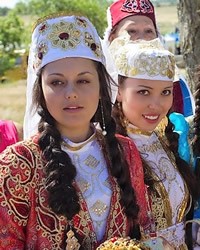Throughout history, Armenia has been a battlefield for many invaders and contending empires, and a bridge for many cultures and civilizations. During the past 2,700 years, Armenia has been conquered by the Persian Empire, Alexander the Great, the Roman Empire, the Byzantines, Arabs, Mongols, Tatars, Ottomans, Persians, and Russians. Armenian kingdoms, principalities, and even a short-lived empire (95-55 B.C.) managed to survive and thrive for some 1,700 years. Under various kings and princes, the Armenians developed a sophisticated culture, an original architecture, and their own alphabet.The 1905 Russian revolution and the 1908 Young Turk revolution raised the hopes of the Armenians for reform, and an opportunity to build a homeland in historical Armenia. These hopes were dashed as the Ottoman and the Russian Empires fought each other during World War I. A dark hour of Armenian history is the Armenian genocide, which started on April 24, 1915. Some 1,750,000 Armenians were deported into Syria and Mesopotamia by the Ottoman authorities. Subject to famine, disease, and systematic massacres, most of them perished. This "ethnic cleansing" of the Armenians from their historical homeland led Raphael Lemkin, the father of the Genocide Treaty, to coin the new term "genocide" in the 1930s to describe the historical plight of the Assyrians and the Armenians as subjects of the first genocide of the 20th century. Armenia gained independence on September 23, 1991.Today, there are several million Armenians worldwide. Significant numbers are located in Armenia and the United States of America. Major diaspora centers of the Middle East are Iran, Syria, and Lebanon. There are also Armenian communities in some of the Latin American countries, such as Uruguay.The Armenian-Uruguayan community is one of the oldest in South America, primarily living in the city of Montevideo. Armenians began to settle in Uruguay during the late 19th century, mainly migrating from Armenia, Syria, and Lebanon – fleeing from the genocide to find a home. The early Armenian migrants began work as laborers or small shopkeepers mainly for shoe workshops in Montevideo, which explains all the various signs, both translated in Spanish and Armenian.
Over the decades, many prominent Armenians have been recognized for their professional and academic life as doctors and professors. Today, numerous community centers are open, bringing the community together to preserve their traditional practices and enrich their traditions with a love for their country. These community centers include churches, ladies' associations, and community groups that play an active role in cultural and social engagement. The churches remain an integral part of their community with one Apostolic church, a Catholic Church, and two Evangelical churches. Alongside this, two-day schools are also open to allow Armenian children to have access to an education that also integrates their national history and culture.Their love for art continues as they hold extravagant concerts to showcase their love for music, dance, orchestra, and theater performances.Uruguay was the first country to officially recognize the Armenian Genocide on the 24th of April, marked with a Remembrance Day and various monuments throughout the city. The Uruguayan community also contributes with donations and materials to the Armenian Genocide Museum. The Armenians in Uruguay are not only treated with love and respect for their positive impact on the country, both economically and politically, but are also honored for their heart-wrenching history.
In 301 AD, during the rule of King Dirtad III, Armenia became the world's first Christian nation. A Christian monk, commonly known as Krikor Lusavorich or St. Gregory the Illuminator, cured the King of a disease. After this event, King Dirtad III was baptized and accepted Christianity as Armenia's official state religion. Before this, two disciples had brought Christianity to Armenia, St. Thaddeus and St. Bartholomew.Spiritually, Armenians are still Christian, but their faith in Christ has often taken the back seat to nationalism or a faith in their heritage. Every generation needs a fresh work of the Holy Spirit to move them to full devotion to Jesus Christ.
Armenians need the Holy Spirit to move in their families and their churches so they can enjoy the abundant life that only Jesus offers.
Pray for the Armenians in Uruguay to be salt and light to those who don't know the only Savior.Pray for spiritual peace; this is what Armenia needs most of all.Pray that God would bring revelation of Christianity as a spiritual relationship, and that Armenians would realize they can have joy and peace as they follow the Lord.Pray for their businesses to flourish as a testimony of God's power and goodness.Pray for God to open the eyes of the Armenians in Uruguay that they may come to know Christ.Pray that the Armenians would recognize God's providence and hand guiding them to countries where they are welcomed, honored, and loved.
Scripture Prayers for the Armenian in Uruguay.
Middle East Resourceshttps://en.wikipedia.org/wiki/Armenian_Uruguayanshttps://mirrorspectator.com/2021/12/02/hola-from-montevideo/http://diaspora.gov.am/en/pages/10/uruguayhttps://armenpress.am/en/article/1083063https://www.armeniavoice.com/post/the-armenian-genocide-and-a-genesis-of-the-diaspora-where-s-our-home-nannyhttps://mirrorspectator.com/2021/12/02/hola-from-montevideohttps://massispost.com/2021/05/for-the-armenian-community-of-uruguay-a-welcoming-country
| Profile Source: Joshua Project |












